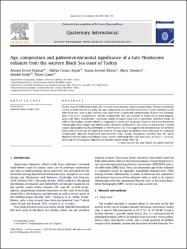| dc.contributor.author | Erginal, Ahmet Evren | en_US |
| dc.contributor.author | Güneç Kıyak, Nafiye | en_US |
| dc.contributor.author | Ekinci, Yunus Levent | en_US |
| dc.contributor.author | Demirci, Alper | en_US |
| dc.contributor.author | Ertek, Topçu Ahmet | en_US |
| dc.contributor.author | Canel, Timur | en_US |
| dc.date.accessioned | 2015-01-15T23:02:17Z | |
| dc.date.available | 2015-01-15T23:02:17Z | |
| dc.date.issued | 2013-05-16 | |
| dc.identifier.citation | Erginal, A. E., Güneç Kıyak, N., Ekinci, Y. L., Demirci, A., Ertek, A. & Canel, T. (2013). Age, composition and paleoenvironmental significance of a late pleistocene eolianite from the western black sea coast of turkey. Quaternary International, 296, 168-175. doi:10.1016/j.quaint.2012.04.031 | en_US |
| dc.identifier.issn | 1040-6182 | |
| dc.identifier.issn | 1873-4553 | |
| dc.identifier.uri | https://hdl.handle.net/11729/490 | |
| dc.identifier.uri | http://dx.doi.org/10.1016/j.quaint.2012.04.031 | |
| dc.description.abstract | On the basis of field observations, thin section interpretations, microanalytical data, electrical resistivity survey and luminescence dating, the age, composition and internal structure of coastal eolianite on the west Black Sea coast at Sile, Istanbul, was studied for a combined interpretation of dune rock development and facies characteristics. Results demonstrate that the eolianite is made up of south-dipping, large-scale dune stratification, consisting mainly of quartz sand and, in particular, abundant ooids, as well as the binding cement which is composed of calcite and aragonite. Based on Electrical Resistivity Tomography (ERT) images, the eolianite has a thickness of between 3.5 m and 8 m and overlies a buried rugged topography that has developed on the Pliocene unit. This suggests the predominance of northerly winds that account for the landward removal of dune sands by offshore wind drift prior to carbonate cementation. Optically Stimulated Luminescence (OSL) dating estimations revealed that the initial deposition of the laminated eolianite layers on the underlying older unit took place at 138.57 +/- 13.65 ka, matching the Karangatian highstand or Marine Isotope Stage (MIS) 5e. | en_US |
| dc.language.iso | eng | en_US |
| dc.publisher | Pergamon-Elsevier Science Ltd | en_US |
| dc.relation.isversionof | 10.1016/j.quaint.2012.04.031 | |
| dc.rights | info:eu-repo/semantics/closedAccess | en_US |
| dc.subject | Level highstands | en_US |
| dc.subject | Marmara region | en_US |
| dc.subject | Single-Aliquot | en_US |
| dc.subject | Island | en_US |
| dc.subject | Bahamas | en_US |
| dc.subject | Quartz | en_US |
| dc.title | Age, composition and paleoenvironmental significance of a Late Pleistocene eolianite from the western Black Sea coast of Turkey | en_US |
| dc.type | article | en_US |
| dc.description.version | Publisher's Version | en_US |
| dc.relation.journal | Quaternary International | en_US |
| dc.contributor.department | Işık Üniversitesi, Fen Edebiyat Fakültesi, Fizik Bölümü | en_US |
| dc.contributor.department | Işık University, Faculty of Arts and Sciences, Department of Physics | en_US |
| dc.identifier.volume | 296 | |
| dc.identifier.startpage | 168 | |
| dc.identifier.endpage | 175 | |
| dc.peerreviewed | Yes | en_US |
| dc.publicationstatus | Published | en_US |
| dc.relation.publicationcategory | Makale - Uluslararası Hakemli Dergi - Kurum Öğretim Elemanı | en_US |
| dc.contributor.institutionauthor | Güneç Kıyak, Nafiye | en_US |
| dc.relation.index | WOS | en_US |
| dc.relation.index | Scopus | en_US |
| dc.relation.index | Science Citation Index Expanded (SCI-EXPANDED) | en_US |
| dc.description.quality | Q3 | |
| dc.description.wosid | WOS:000319634500018 | |


















